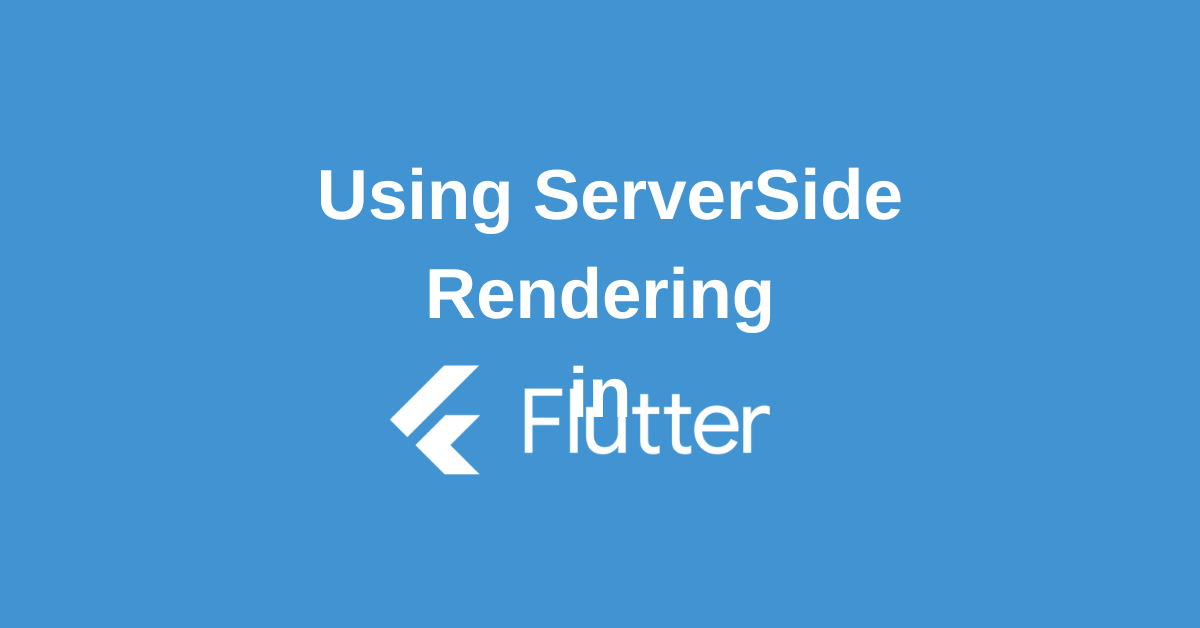In the realm of web development, performance and search engine optimization (SEO) are two crucial factors that can significantly impact a website’s success. Flutter, Google’s UI toolkit, has gained significant traction for building cross-platform applications, including web apps. While Flutter’s hot reload feature and rich widget library offer a great development experience, Server-Side Rendering (SSR) can further enhance performance and SEO for Flutter web apps.
This blog post will explore the concept of Flutter Web SSR, its benefits, and how to implement it effectively. By understanding the advantages of SSR and following best practices, you can create high-performing Flutter web apps that rank well in search engine results.
Decoding Server Side Rendering: An Essential in Modern Web Apps
As a Flutter developer, you’re familiar with the significance of rendering in web apps. There are two primary rendering methods: client-side and server-side. Historically, client-side rendering was the standard for front-end applications. However, it poses SEO challenges due to search engines’ difficulties in indexing JavaScript-heavy pages.
Server-side rendering addresses this issue by generating the initial page structure on the server. This improves search engine indexing and SEO. Developers increasingly recognize the benefits of server-side rendering, especially in projects where SEO is a priority.
/ Initial state of a Web Application with SSR:
void main() {
runApp(MyApp());
}
class MyApp extends StatelessWidget {
@override
Widget build(BuildContext context) {
return MaterialApp(
title: 'Flutter SSR App',
home: PageContent(), // This PageContent widget is pre-filled with content from the server
);
}
}In the code snippet above, the app’s initial state is built with server-side-processed HTML content. The server, thus, takes an active role in page generation, providing immediate access to the content for the client.
In the context of Flutter, the integration of Server Side Rendering opens up exciting opportunities for enhancing the performance of web apps and making them SEO friendly. But how does Flutter support Server Side Rendering?
Understanding Flutter Web SSR: Bridging Server Side and Client Side
The Magic Behind Flutter Web SSR
Flutter’s unique capability to compile Dart code into platform-specific code is a key advantage. In Flutter Web SSR, the server handles the initial rendering of the web page, including the full HTML content and necessary Flutter Widgets. This initial rendering enhances performance and SEO.
// Rendering HTML with SSR in a Flutter Web application:
void main() {
runApp(ServerRenderedApp());
}
class ServerRenderedApp extends StatelessWidget {
@override
Widget build(BuildContext context) {
return MaterialApp(
title: 'Server Rendered Flutter Web App',
home: HtmlRenderedPage(), // The server provides this widget, rendered as HTML
);
}
}In the code excerpt above, the app is constructed with an HTML-rendered page from the server. This enables immediate interaction with the website: users can start interacting with the content immediately as it is available in the HTML delivered to their browser.
Setting up SSR in Flutter Web: Taking a Step Towards Better Performance and SEO
To begin, you’ll need essential tools and skills for server-side rendering. Flutter Web SSR offers a performance advantage over client-side rendering.
With SSR, the initial web page is pre-rendered on the server, reducing load times and improving user experience, especially on mobile devices. The server sends the fully rendered HTML directly to the browser, optimizing performance.
Scrutinizing Performance and SEO Upgrades with SSR in Flutter
Assuring Stellar App Performance with Flutter SSR
Server-Side Rendering (SSR) is a valuable technique for optimizing Flutter web app performance. By pre-rendering web pages, SSR reduces client-side load and render times, leading to faster page loads and a smoother user experience.
For instance, consider a complex Flutter Widget that requires substantial loading time. While client-side rendering might cause delays, especially on mobile devices, SSR effectively addresses this issue.
// Example of a Widget with heavy data
class HeavyDataWidget extends StatelessWidget {
@override
Widget build(BuildContext context) {
// Fetch and process data server side before building the widget
// Prepare HTML content from the widget output and send to the client
return Container(); // returns an HTML-rendered Container Widget
}
}By generating the HTML content at the server, users can start interacting with a fully-loaded page—even before the Flutter framework starts executing in the browser.
SEO Perks with Flutter SSR
Server-Side Rendering (SSR) is a significant advantage for SEO in Flutter web apps. By rendering the initial page on the server, the entire HTML content is available to the browser immediately after parsing. This improves time-to-content for users and allows search engine bots to index the page efficiently, boosting SEO rankings.
The following example demonstrates how Flutter Web SSR can be used to enhance SEO by rendering a web page’s HTML content on the server.
// Sample SEO-optimized page title using SSR in Flutter
class SeoOptimizedPage extends StatelessWidget {
@override
Widget build(BuildContext context) {
return MaterialApp(
title: 'This is an SEO-optimized title for search engines',
home: HtmlRenderedPage(),
);
}
}
Conclusion
Flutter Web SSR offers a powerful solution for improving performance and SEO in your Flutter web applications. By rendering the initial HTML on the server-side, you can provide a faster initial load time, enhance SEO, and improve the overall user experience. By following the best practices outlined in this blog post, you can effectively implement Flutter Web SSR and reap its benefits.

